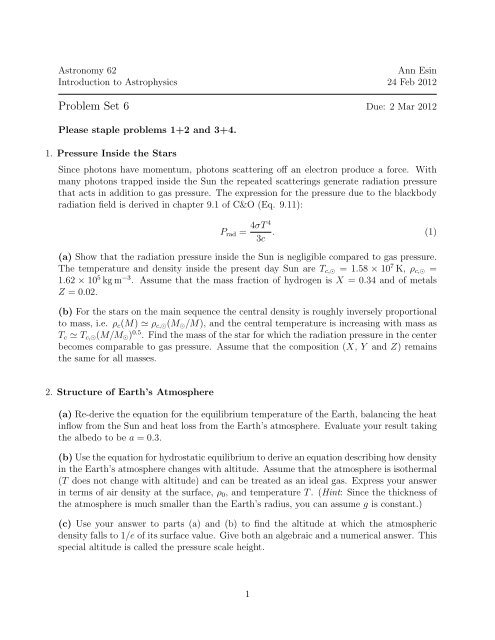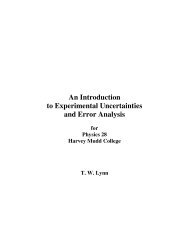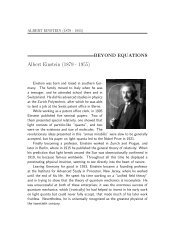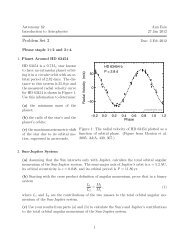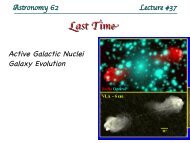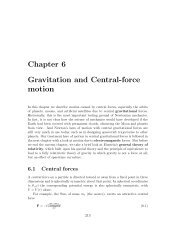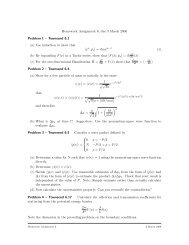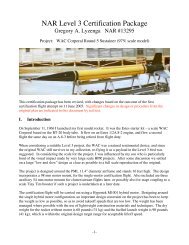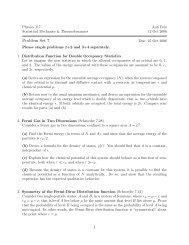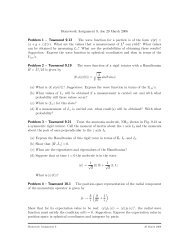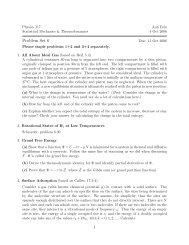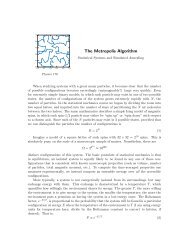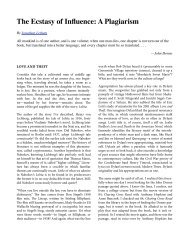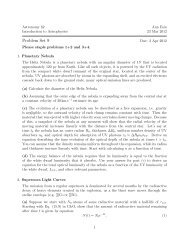Problem Set 6 - HMC Physics
Problem Set 6 - HMC Physics
Problem Set 6 - HMC Physics
- No tags were found...
You also want an ePaper? Increase the reach of your titles
YUMPU automatically turns print PDFs into web optimized ePapers that Google loves.
Astronomy 62Ann EsinIntroduction to Astrophysics 24 Feb 2012<strong>Problem</strong> <strong>Set</strong> 6 Due: 2 Mar 2012Please staple problems 1+2 and 3+4.1. Pressure Inside the StarsSince photons have momentum, photons scattering off an electron produce a force. Withmany photons trapped inside the Sun the repeated scatterings generate radiation pressurethat acts in addition to gas pressure. The expression for the pressure due to the blackbodyradiation field is derived in chapter 9.1 of C&O (Eq. 9.11):P rad = 4σT 43c . (1)(a) Show that the radiation pressure inside the Sun is negligible compared to gas pressure.The temperature and density inside the present day Sun are T c,⊙ = 1.58 × 10 7 K, ρ c,⊙ =1.62 × 10 5 kg m −3 . Assume that the mass fraction of hydrogen is X = 0.34 and of metalsZ = 0.02.(b) For the stars on the main sequence the central density is roughly inversely proportionalto mass, i.e. ρ c (M) ≃ ρ c,⊙ (M ⊙ /M), and the central temperature is increasing with mass asT c ≃ T c,⊙ (M/M ⊙ ) 0.5 . Find the mass of the star for which the radiation pressure in the centerbecomes comparable to gas pressure. Assume that the composition (X, Y and Z) remainsthe same for all masses.2. Structure of Earth’s Atmosphere(a) Re-derive the equation for the equilibrium temperature of the Earth, balancing the heatinflow from the Sun and heat loss from the Earth’s atmosphere. Evaluate your result takingthe albedo to be a = 0.3.(b) Use the equation for hydrostatic equilibrium to derive an equation describing how densityin the Earth’s atmosphere changes with altitude. Assume that the atmosphere is isothermal(T does not change with altitude) and can be treated as an ideal gas. Express your answerin terms of air density at the surface, ρ 0 , and temperature T . (Hint: Since the thickness ofthe atmosphere is much smaller than the Earth’s radius, you can assume g is constant.)(c) Use your answer to parts (a) and (b) to find the altitude at which the atmosphericdensity falls to 1/e of its surface value. Give both an algebraic and a numerical answer. Thisspecial altitude is called the pressure scale height.1
3. Chemical Energy<strong>Problem</strong> 10.3 in C&O.4. Mass Loss from the SunThe Sun is constantly losing mass by converting it to energy via nuclear reactions and throughlaunching of the solar wind. Solar wind is a continuous stream of high-energy electrons andions escaping from the Sun.(a) Calculate the escape speed at the surface of the Sun. This gives us an order of magnitudeestimate for the speed of the solar wind particles, v sw .(b) Assume that the solar wind is launched isotropically. Show that the rate at which thesolar wind matter is crossing a spherical surface of radius r is equal to( dMdt)sw= 4πr 2 ρv sw . (2)Hint: Start by calculating the mass contained is a thin shell of radius r and thickness v sw dt.Evaluate the solar wind mass loss rate if the solar wind contains mostly protons and theirnumber density at r = 1 AU is n = 7 × 10 6 m −3 .(c) Calculate (dM/dt) nuc , the rate at which the Sun’s mass is decreasing due to nuclearreactions.(d) Compare your answers parts (b) and (c). Assuming that the mass loss rates remainconstant, would either mass loss process significantly affect the total mass of the Sun overits main-sequence lifetime?2


